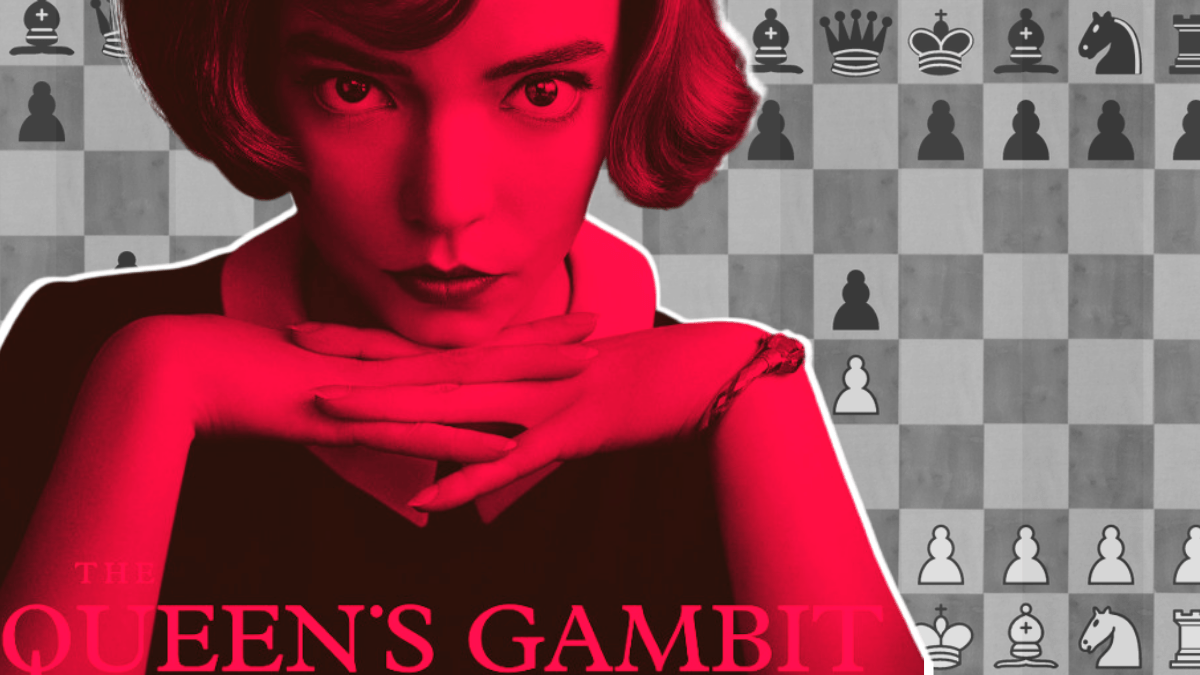“I would say it is much easier to play chess without an Adam’s apple.”
~Beth Harmon, The Queen’s Gambit
The new Netflix mini series The Queen’s Gambit gyrates around the life of Beth Harmon played by Anna Taylor Joy and directed by Scott Frank. Set in the cold war period, it is a story of a chess prodigy and about co-learning from each other rather than just an insatiable spirit of winning. Based on the 1983 novel by Walter Tevis, the series follows the life of an 8 year old girl whose mother dies in a car accident. Soon she ends up in an orphanage and stumbles upon the janitor playing chess in the basement. From the first time she lays eyes on the chess board, she is obsessed with it.
Reluctantly, the janitor teaches Beth how to play the game, only to discover that she is a prodigy. The fast-paced show soon takes us on a journey of consecutive victories of Beth Harmon until she is adopted and is put into a different life. Soon she overcomes the hurdles at her adoptive home and continues the journey of national and international victories. Beth simultaneously is forced to face her eccentricities that lay beyond the 64 squares as she deals with alcoholism and addiction to tranquilizers.
Unlike the popular idea of feminist shows, the central theme of having a strong female lead is not crushing patriarchy. The Queen’s Gambit has an authentic portrayal of woman characters, and in that authenticity of portrayal, feminism simply exists and need not be forced down. It is interesting to see that the portrayal of a strong woman is the antithesis of the conventional patriarchal structure. When honestly left free without interference of patriarchal wisdom, the strongest ideas of feminism manifests itself in its organic strength in the life of the characters.
Unlike the popular idea of feminist shows, the central theme of having a strong female lead is not crushing patriarchy. The Queen’s Gambit has an authentic portrayal of woman characters, and in that authenticity of portrayal, feminism simply exists and need not be forced down.
Beth’s journey isn’t an easy one. In her first tournament match, she is asked to play against a female player which tells us much about her journey to come. There are no verbal duels or aggressive monologues, she dismantles sexism with battles on a board of 64 squares. Beth is not a Katniss Everdeen from Hunger Games or Tris from Divergent and doesn’t require physical power to show you how strong she is. Beth Harmon will not be mollycoddled to fit your typical tropes—she is authentic, determined and fearless. She is simply Beth Harmon, the quintessential bona fide feminist we need.
Also read: Feminist Cinema: The Economics And Politics Of It
The show skillfully dismantles the trope of ‘smart girls are less attractive’ and that they need to look a certain way to be deemed smart. We have seen Hollywood having a history of portraying smart woman as a Diane Nguyen from Bojack Horseman or Cady from Mean Girls. Women who are considered less attractive or even less ‘feminine’ are fun purely because they are smart. The show also deals with gender roles with utmost sensitivity.
The idea of “not like other girls” is another trope that comes around when talking about smart women in cinema. From Dorothy in Jerry Maguire to Lara Jean in To all the boys I have loved before, Hollywood has tried hard to mollycoddle women. The problem with this trope of “not being like other girls” is that it diminishes other women and tells them that being a woman is something inferior. Beth Harmon does not look at herself as someone who is different from other woman in spite of the world repeatedly telling her that she is. She embraces her innate nature without being bothered by worldly claims.
Beth Harmon’s transformation is a notable one, from her clothing to her poise. The transformation happens throughout the show and goes naturally with her game. The richer she gets the more she is able to buy, and that buying power gives her the freedom to feed her love for clothing—this is interesting to see as this is a highly unusual phenomenon. When a young girl goes through something important in her life, her change is expected to be drastic like Mia going through a dramatic transformation in Princess Diaries to be socially acceptable and liked.
The problem with this trope of “not being like other girls” is that it diminishes other women and tells them that being a woman is something inferior. Beth Harmon does not look at herself as someone who is different from other woman in spite of the world repeatedly telling her that she is. She embraces her innate nature without being bothered by worldly claims.
Clothing colours are often used to address the level of idealism a woman embodies. Joan and Peggy Olsen from popular show Mad Men are a perfect example of the same. Joan is seen wearing flamboyant colours to enhance her sexual appeal whereas Peggy Olsen wears sobered down colours to portray a decrease in sexual appeal. Beth Harmon wears whatever she pleases to wear, she isn’t made to check boxes according to societal needs of a femininity. Beth Harmon breaks the glass box called social construct and redefines the idea of femininity as “whatever the hell you want it to be.”

The Queen’s Gambit also closely deals with addiction to tranquilizers and alcoholism. The portrayal of her mental health gives us a peek into her personal life and emotions. You see a person who longs to connect with people in spite of having everything she could ask for. It demystifies the idea, that if a person is successful there is no reason to not be fine. At her worst you see Jolene, played by Moses Ingram making a comeback in Beth’s life. Jolene is Beth’s friend since her time in orphanage.
Also read: An Enquiry Into Internalised Male Gaze: Whose Camera Is It Anyway?
Beth embraces her sisterhood with her friend Jolene, who happens to be a Black woman. Jolene’s portrayal breaks free from all stereotypes as you see a woman of a colour who is warm and happy and a constant source of support to Beth. This breaks free from the common popular media trope of an Annalise Keating from How To Get Away With Murder or an Olivia Pope from Scandal, who have their personal lives become a mess because they are designed to fit into the “angry black woman” trope.
The Queen’s Gambit shows you how authenticity in portrayal is in itself an act of feminism of the highest order.
About the author(s)
Shivani Menon is an ardent reader and cinephile, who spends most of her time amidst books and the remaining time binging on classic movies. She describes herself with a quote by Sartre, "I exist, that is all and I find it nauseating."




